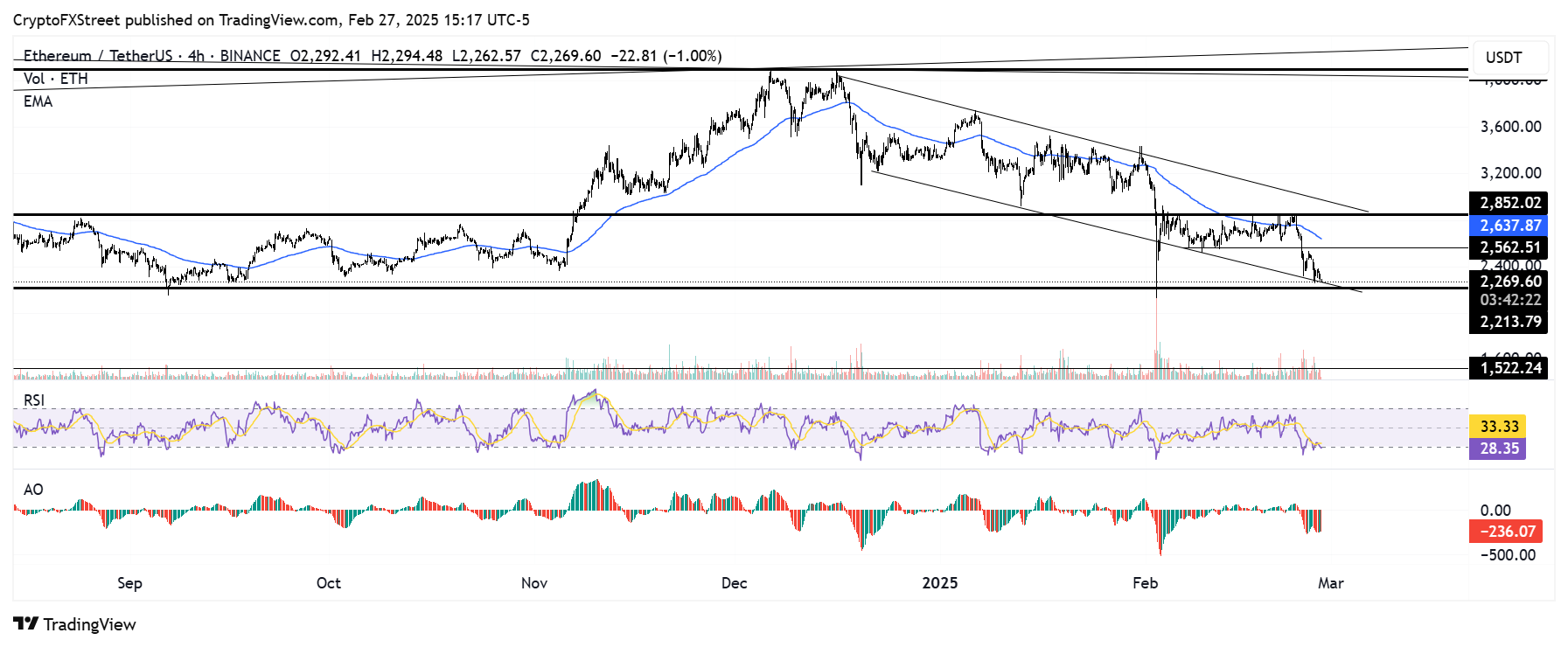Ethereum Price Forecast: Pectra upgrade still on track despite recent failure, ETH challenges $2,200 support
Ethereum price today: $2,270
- Ethereum developers agreed to move forward with the Pectra upgrade on the Sepolia testnet despite having issues with the Holesky testnet upgrade.
- Ethereum ETFs posted their longest outflow streak since November after five days of negative flows.
- ETH could suffer a further breakdown to $1,500 if buyers fail to defend the $2,200 support.
Ethereum (ETH) trades near $2,270 on Thursday following its latest All Core Developers Consensus (ACDC) call, where developers agreed to carry on with deploying the Pectra upgrade on the Sepolia testnet on March 5 despite failure on the Holesky testnet.
Ethereum Pectra upgrade schedule remains intact despite Holesky failure
In its latest ACDC call on Thursday, Ethereum developers agreed to continue with the initial schedule for the upcoming Pectra upgrade despite running into issues with its implementation on the Holesky testnet — an environment for testing new blockchain features before they go live on the Mainnet.
Developers decided to move forward with the next step of deploying Pectra on the Sepolia testnet on March 5 while working on better mitigations and recovery strategies to prevent the issues with Holesky from repeating itself.
Holesky failed to finalize after undergoing the Pectra upgrade on Monday due to a bug with execution layer clients.
However, developers have assured users that the bug does not affect the subsequent Pectra deployment on the Sepolia testnet and Ethereum Mainnet.
If Pectra's deployment on the Sepolia testnet is successful, the Mainnet upgrade is expected sometime in April.
The Pectra upgrade will introduce several features to Ethereum that will improve the user experience. Some of the most anticipated features include sponsored transactions, payment of gas fees with ERC-20 tokens and improved wallet recovery options.
Pectra will also enable stakers to consolidate their resources by increasing the maximum staking balance per node from 32 ETH to 2,048 ETH.
Investors could flock back to Ethereum if the Pectra upgrade on Mainnet is successful.
Meanwhile, Ethereum exchange-traded funds (ETFs) recorded outflows of $94.3 million on Wednesday, marking a fifth consecutive day of negative flows — its longest since November, per Coinglass data.
Ethereum Price Forecast: ETH needs to hold $2,200 to prevent further decline
Ethereum experienced $62.48 million in futures liquidations in the past 24 hours, per Coinglass data. The total amount of long and short liquidations accounted for $42.77 million and $19.71 million, respectively.
The top altcoin's momentum is tilted toward the downside since it declined below the $2,560 support on Monday.

ETH/USDT 4-hour chart
ETH is looking for support near the convergence of a descending channel and rectangular channel lower boundary lines at $2,200. If buyers fail to defend the $2,200 key level, ETH could decline to test the support near $1,500.
The Relative Strength Index (RSI) and Awesome Oscillator (AO) are below their neutral levels, indicating dominant bearish momentum.
A daily candlestick close above the descending channel's upper boundary will invalidate the thesis.
Ethereum FAQs
Ethereum is a decentralized open-source blockchain with smart contracts functionality. Its native currency Ether (ETH), is the second-largest cryptocurrency and number one altcoin by market capitalization. The Ethereum network is tailored for building crypto solutions like decentralized finance (DeFi), GameFi, non-fungible tokens (NFTs), decentralized autonomous organizations (DAOs), etc.
Ethereum is a public decentralized blockchain technology, where developers can build and deploy applications that function without the need for a central authority. To make this easier, the network leverages the Solidity programming language and Ethereum virtual machine which helps developers create and launch applications with smart contract functionality.
Smart contracts are publicly verifiable codes that automates agreements between two or more parties. Basically, these codes self-execute encoded actions when predetermined conditions are met.
Staking is a process of earning yield on your idle crypto assets by locking them in a crypto protocol for a specified duration as a means of contributing to its security. Ethereum transitioned from a Proof-of-Work (PoW) to a Proof-of-Stake (PoS) consensus mechanism on September 15, 2022, in an event christened “The Merge.” The Merge was a key part of Ethereum's roadmap to achieve high-level scalability, decentralization and security while remaining sustainable. Unlike PoW, which requires the use of expensive hardware, PoS reduces the barrier of entry for validators by leveraging the use of crypto tokens as the core foundation of its consensus process.
Gas is the unit for measuring transaction fees that users pay for conducting transactions on Ethereum. During periods of network congestion, gas can be extremely high, causing validators to prioritize transactions based on their fees.

